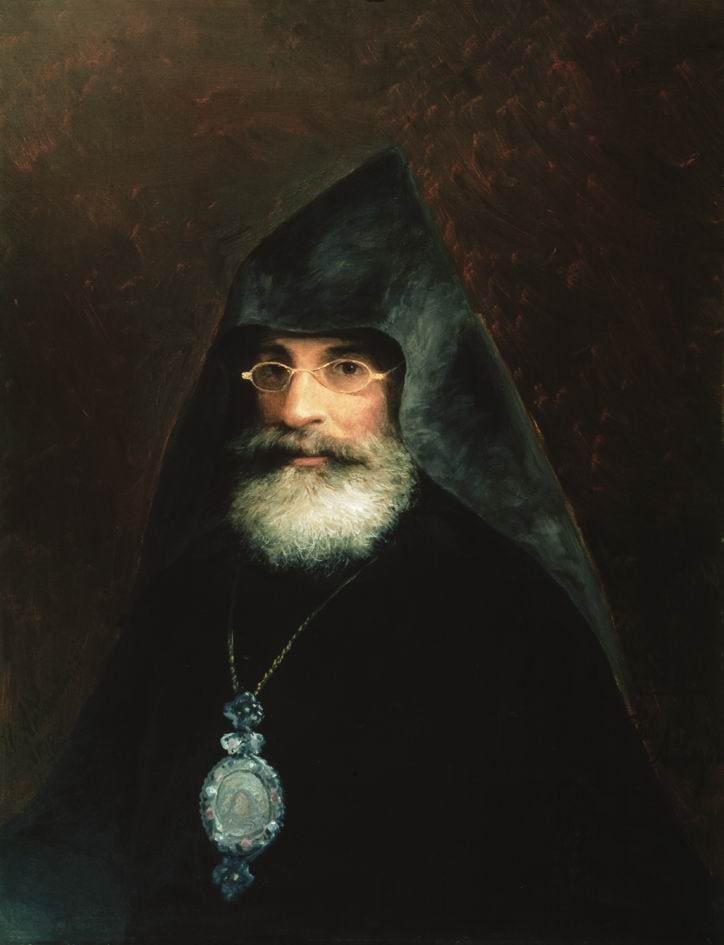Archbishop Gabriel Aivazovsky was the elder brother of the celebrated marinist painter Ivan Aivazovsky (1817-1900) and a devoted ecclesiastic and scholar.
He was born Alexander Aivazovsky in Feodosiya (Crimea) on May 22, 1812, into a family of Armenian merchants. In 1826, at the age of fourteen, he was sent to the island of San Lazzaro, in Venice, which was home to the Mekhitarist Congregation. In 1834, he was elevated to the rank of vartabed. He mastered a dozen languages, but his main working language was Classical Armenian, and he also taught European and Oriental languages, theology, and philosophy at the monastery school. In 1836, he published his “Essay on the History of Russia,” followed by his two-volume “History of the Ottoman State” in 1841.
In 1843, young priests Gabriel Aivazovsky and Ghevont Alishan (1820-1901) founded and began publishing the historical and philological journal “Bazmavep,” which became the first scholarly publication in the history of the Armenian press. Aivazovsky served as editor of the journal until 1848. He also taught at the Murad-Raphaelian College of Venice (1842-1848). In 1848, at the suggestion of the Vatican, Gabriel set out for Paris, where he became principal of the Samuel Muradian Lyceum, which also belonged to the Mekhitarists, between 1848 and 1856.
The Vatican became increasingly discontent with the fact that not only Catholics, but also followers of the Armenian Apostolic Church studied at the college, which was under Vatican jurisdiction. Aivazovsky, on his part, became frustrated by the ceaseless pressure that he faced at the lyceum. To resolve the conflict, in 1856, he renounced Catholicism and returned to the fold of his national church. For the next two years, he published an illustrated journal, “Masiats Aghavni” (Dove of Masis), in Armenian and French.
In 1858, upon the suggestion of his younger brother Hovhannes, the priest returned to Russia, where he was appointed head of the Armenian Diocese in Bessarabia and New Nakhichevan. He moved the headquarters of the Diocese from Kishinev (nowadays Chisinau) to Feodosia. During the time he spent in New Nakhichevan (now one of the city districts of Rostov-on-Don), he became close to its mayor, the art patron Harutiun Khalibian (Artemius Khalibov), a connection that would play a significant role in his life. In 1858, with Khalibian’s support, Aivazovsky founded the Khalibian School and was its principal until 1865. He also continued the publication of his journal “Masiats Aghavni” in Armenian, French, and Russian until 1865. Internal disputes boiled down to his resignation from the position of primate (1867) and the closure of the school (1871).
In 1872, Aivazovsky was invited to the Mother See of Holy Etchmiadzin and ordained bishop by Catholicos Gevorg IV, who appointed him dean of the Kevorkian Seminary (1874-1876). He was later elevated to the rank of archbishop, becoming the head of the Armenian Diocese of Georgia. Besides his works of history, philology, and many translations, Aivazovsky was the author of various religious works, such as a life of Christ (1854), textbooks on the Orthodox faith of the Armenian Church (1858 and 1875), and a history of the conversion to Catholicism of the Armenian community of Poland (1877), among others.
He passed away on April 20, 1880, and was buried in Tiflis (Tbilisi), where thousands a people attended his funeral.

